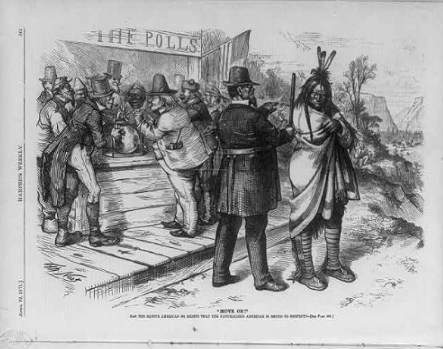
A policeman was telling the Native American to move away from the voting poll. Source: Library of Congress
"Between the Revolutionary War and the aftermath of the Civil War, over the course of almost a century, the United States and Native American nations signed 368 treaties that would define their relationship for centuries to come. The treaties keyed off the fundamental idea that each tribal group was an independent nation, with their own right to self-determination and self-rule. But as white settlers began moving onto Native American lands, this idea came into conflict with the relentless pace of westward expansion—resulting in many broken promises on the part of the U.S. government." (Pruitt)

A policeman was telling the Native American to move away from the voting poll. Source: Library of Congress
"Move on!" Has the Native American have no rights that the naturalized American is bound to respect? A policeman ordering a Native man to "move on" away from a voting polls around which are clustered stereotyped "naturalized" Americans.
"The rights of status of Native Americans and the disposition of Native American lands were hotly debated in U.S. newspapers and magazines in the nineteenth century. However, Native voices were rarely included, and depictions of Native Americans, even by those who advocated for Native American rights, were often rife with racist language and imagery" (Library of Congress)
"In September 1778, representatives of the newly formed Continental Congress signed a treaty with the Lenape (Delaware) at Fort Pitt, Pennsylvania. In the first official peace treaty between the new United States and a Native American nation, both sides agreed to maintain friendship and support each other against the British." (Pruitt)
"But mutual suspicion continued, especially after Pennsylvania militiamen killed nearly 100 Lenape (most of them women and children) at the village of Gnadenhutten in March 1782, mistakenly believing they were responsible for attacks against white settlers. After the American victory, more and more white settlers moved onto Lenape territory, until the Treaty of Greeneville in 1795 forced them and other Ohio Country Native Americans to surrender most of their lands." (Pruitt)
"In the years following the Revolutionary War, Andrew Pickens and other commissioners of the new U.S. government concluded three highly similar treaties with the Cherokee, Choctaw and Cherokee Nations at Hopewell, Pickens’ plantation home in northwestern South Carolina." (Pruitt)
"Collectively known as the Treaty of Hopewell, these agreements extended the friendship and “protection” of the United States to the southern Native American tribes; all three ended with the same sentence: “The hatchet shall be forever buried, and peace given by the United States of America." Despite this sentiment, white settlers were already moving onto the lands designated for the Cherokee, leading to more conflict and the Treaty of Holston (1791), in which the Cherokee forfeited still more land." (Pruitt)
"The treaty restored more than 1 million acres of land to the Seneca that had been ceded by treaty 10 years earlier and recognized the sovereignty of the Six Nations to govern themselves and set laws. It also promised an annual payment by the United States to the Haudenosaunee of $4,500 in goods, including calico cloth. " (Pruitt)
"Over the years, as the Six Nations’ territory was further reduced, the Onondaga, Seneca, Tuscarora and some Oneida remained in New York on reservations, while the Mohawk and Cayuga left for Canada and the Oneida settled in Wisconsin and Ontario." (Pruitt)
"As more white settlers moved west into the Great Lake region, a Native American confederacy including the Shawnee and Delaware, who had already been driven westward by U.S. expansion, as well as the Miami, Ottawa, Ojibwa and Potawatomi, mounted an armed resistance beginning in the late 1780s." (Pruitt)
"After U.S. troops under General “Mad” Anthony Wayne defeated them in the Battle of Fallen Timbers, Miami chief Little Turtle and other Native leaders ceded large parts of what would become Ohio, Michigan, Indiana, Illinois and Wisconsin in the Greeneville Treaty." (Pruitt)
But the treaty provided only short term resolution, as continued U.S. expansion quickly nullified its effect. By 1808, Shawnee war chief Tecumseh had organized a Native confederacy to mount armed resistance to continued U.S. seizure of Native American lands. (Pruitt)
"In this treaty, negotiated by William Henry Harrison, then governor of Indiana Territory, with Native tribes including the Delaware, Potawatomi, Miami and Eel River tribes, the United States acquired 2.5 million acres of land in what is now Michigan, Indiana, Illinois and Ohio, for the equivalent of about two cents per acre. Tecumseh and others argued that the treaty’s signers had no authority to sell the land and warned Americans not to settle there." (Pruitt)
"In 1811, Harrison led an attack on a Native American camp on the Tippecanoe River, beginning a new U.S.-Native conflict that would last through the War of 1812. After Tecumseh’s death in battle in 1813, his confederacy dissolved, along with his dream of Native American independence." (Pruitt)